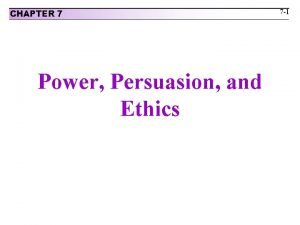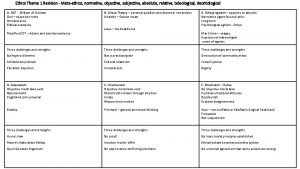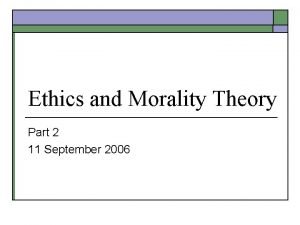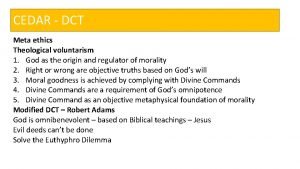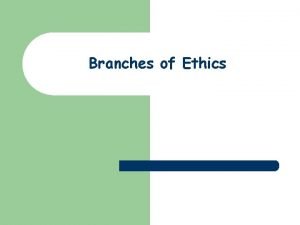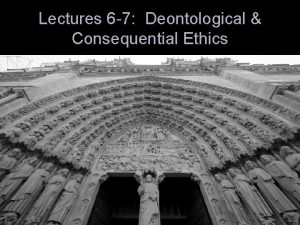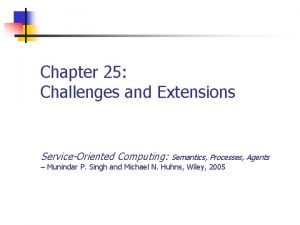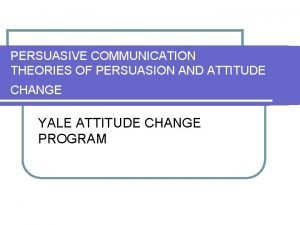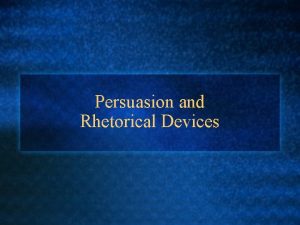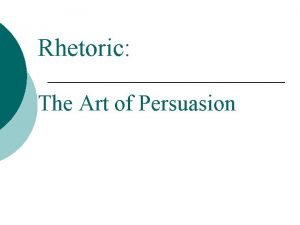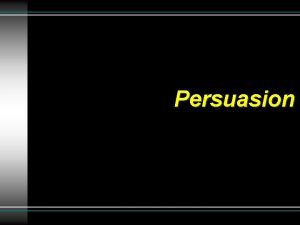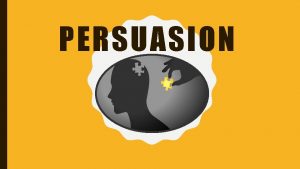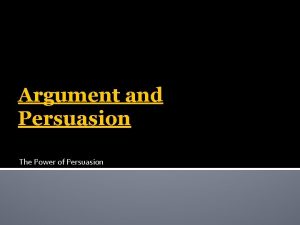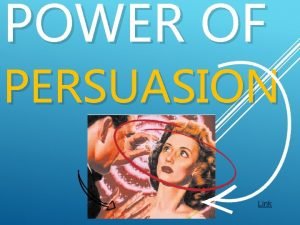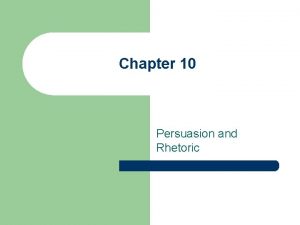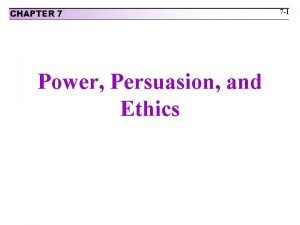CHAPTER 7 Power Persuasion and Ethics 7 1


















- Slides: 18

CHAPTER 7 Power, Persuasion, and Ethics 7 -1

7 -2 CHAPTER 7 Overview • Use as a basis for discussing high-stakes negotiations, multiparty negotiations, or power-differential negotiations • Emphasize that the most important source of negotiator power is one’s BATNA. • Then focus on other types of power such as information, status, social networks, and even physical appearance.

CHAPTER 7 TWO WAYS TO LOOK AT POWER AND PERSUASION STRATEGIES • As the holder of power: chapter presents options for increasing your power in negotiation • Be aware that your counterparty is reading this or another book: Every strategy and tactic could (and will) be used by the counterparty in the future • Remember the “fraternal twin” model 7 -3

CHAPTER 7 Your BATNA is Your Most Important Source of Power in Negotiation • Negotiators must attempt to cultivate and improve upon their BATNAs prior to negotiating • To fully capitalize on BATNA: – Keep your options open – Signal your BATNA, but do not reveal it – Assess the other party’s BATNA • Other sources of power 7 -4

CHAPTER 7 ANALYZING YOUR POWER Four vantage points • • Potential power Perceived power Power tactics Realized power 7 -5

7 -6 CHAPTER 7 PERSUASION TACTICS Not necessarily to have power to be persuasive. Identify techniques negotiators can use to induce attitude and behavior change in their opponents. Two desires are especially important in negotiation: the need to be liked and approved of, and the need to be rational and accurate.

7 -7 CHAPTER 7 PERSUASION TACTICS Two routes to persuasion • Central route • Peripheral route

CHAPTER 7 Central Route Persuasion Tactics • • • The power of agenda The power of alternatives The power of options Attitudinal structuring The power of contrast (the psychological contrast effect) 7 -8

CHAPTER 7 Central Route Persuasion Tactics • Commitment and consistency (the consistency principle) • Framing effects: capitalizing on the half-full or half-empty glass • Fairness heuristics: capitalizing on egocentric bias • Time pressure 7 -9

CHAPTER 7 Peripheral Route Persuasion Tactics • Status – Primary status characteristics – Secondary status characteristics (or pseudostatus characteristics) – Self-fulfilling prophecy – Stereotype threat • Gender – Cultural stereotypes and mental roadblocks – Exposing those negative stereotypes • Social networks – Social capital – Boundary spanners 7 -10

CHAPTER 7 Peripheral Route Persuasion Tactics • • • Physical appearance Delayed liking To err is human Priming the pump Reciprocity versus complementarity Social proof Reactance technique Foot-in-the-door technique Door-in-the-face technique (or rejection-thenretreat tactic) • That’s-not-all technique (or sweetening the deal) 7 -11

CHAPTER 7 7 -12 Ethical Negotiation: Questionable Strategies • Lying (and its effects on negotiation issues) – – – Positions Interests Priorities and preferences BATNAs Reservation prices Facts

CHAPTER 7 7 -13 Ethical Negotiation: Questionable Strategies • Other questionable negotiation strategies – – – Traditional competitive bargaining Manipulation of an opponent’s network Reneging on negotiated agreements Retracting an offer Nickel-and-diming • Sins of omission and commission • Costs of lying

7 -14 CHAPTER 7 Exhibit 7 -5: Conditions under which Negotiators Say They Would Engage in Deception (i. e. , Lying) in Negotiations Review of Categories (Left to Right on X-Axis): Lie-for-a-lie: When I suspect the other party is deceiving me One shot: In a one-shot situation, with no potential for a long-term relationship Personal gain: If there was a gain to be had Not getting caught: If I felt I could get away with it Life or death: If the situation was “life or death” Low power: If the other party had more power (i. e. , to “level the playing field”) Protecting reputation: When I would not have to worry about my reputation Dislike: If I did not like the other person Fixed pie: If the situation was purely distributive

CHAPTER 7 7 -15 Review of Categories (Left to Right on X-Axis): Lie-for-a-lie: When I suspect the other party is deceiving me One shot: In a one-shot situation, with no potential for a long-term relationship Personal gain: If there was a gain to be had Not getting caught: If I felt I could get away with it Life or death: If the situation was “life or death” Low power: If the other party had more power (i. e. , to “level the playing field”) Protecting reputation: When I would not have to worry about my reputati Dislike: If I did not like the other person Fixed pie: If the situation was purely distributive

7 -16 CHAPTER 7 Psychological Bias and Unethical Behavior • Human biases that give rise to ethical problems in negotiation – – Bounded ethicality Illusion of superiority Illusion of control Overconfidence

7 -17 CHAPTER 7 Psychological Bias and Unethical Behavior • How can negotiators calibrate ethical behavior? – – – The front page test Reverse golden rule Role modeling Third-party advice Strengthen your bargaining position

CHAPTER 7 7 -18 CONCLUSION • A larger slice of the pie can be gotten by creating a larger pie • A negotiator’s BATNA is his or her most important source of power in negotiation • Negotiators must continually improve upon their BATNA and signal to the other party that they have alternatives • Negotiators need to be aware of persuasion tactics aimed at the rational side of human behavior (central route) as well as the emotional side (peripheral route) • With all strategies, negotiators should be on the defensive and perform an “ethics check” on their own and others’ behavior
 Persuasive leverage
Persuasive leverage Power triangle diagram
Power triangle diagram Macro ethics definition
Macro ethics definition Persuasion chapter 9
Persuasion chapter 9 Persuasion chapter 7
Persuasion chapter 7 What is environmental ethics
What is environmental ethics Briefly recap
Briefly recap 6075 meaning
6075 meaning Meta ethics vs normative ethics
Meta ethics vs normative ethics Descriptive ethics vs normative ethics
Descriptive ethics vs normative ethics Discipline
Discipline Metaethics vs normative ethics
Metaethics vs normative ethics Descriptive ethics vs normative ethics
Descriptive ethics vs normative ethics Deontological ethics
Deontological ethics Teleological ethics vs deontological ethics
Teleological ethics vs deontological ethics Cognitive dissonance
Cognitive dissonance Yale approach to communication and persuasion
Yale approach to communication and persuasion Cognitively based attitude
Cognitively based attitude Petty and cacioppo's model of persuasion
Petty and cacioppo's model of persuasion




